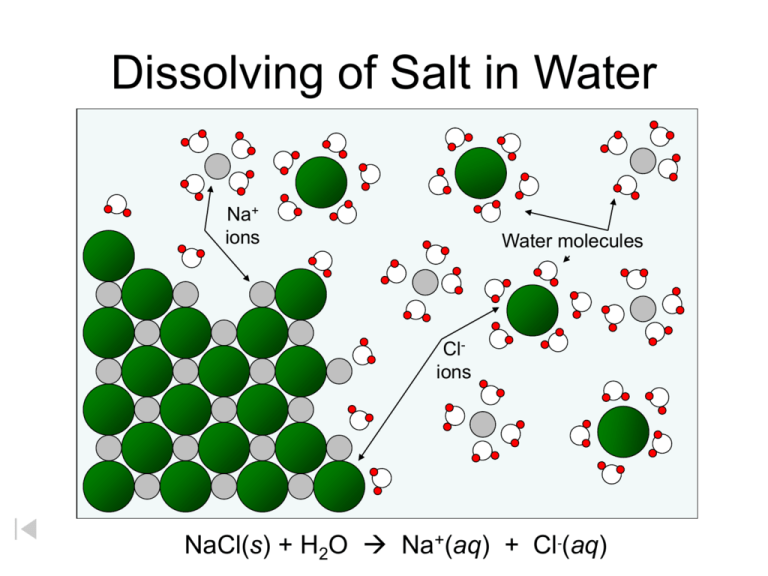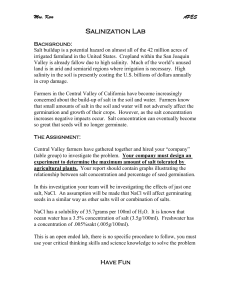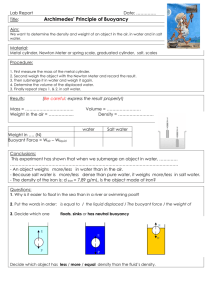
Dissolving of Salt in Water
Na+
ions
Water molecules
Clions
NaCl(s) + H2O Na+(aq) + Cl-(aq)
Determine the minimum amount of salt needed
to make a golf ball float in 100 mL water.
Weigh out 50.0 g of NaCl
Add 5 g additions of salt to the water, dissolve, check to see if ball floats.
Continue with this method of successive additions until ball floats.
Re-weigh remaining salt and subtract this amount from 50.0 g to determine
the amount of salt needed.
Finally, repeat…begin 5 g less salt and add 1 g increments to narrow range.
Trial
Salt (g)
Total
Float /Sink
1
5.0 g
5.0 g
Sink
2
5.0 g
10.0 g
Sink
3
5.0 g
15.0 g
Sink
4
5.0 g
20.0 g
Sink
5
5.0 g
25.0 g
Float
Theorize, but Verify
…We must trust in nothing but
facts. These are presented to us
by nature and cannot deceive. We
ought in every instance to submit
our reasoning to the test
of experiment. It is especially
necessary to guard against the
extravagances of imagination which
incline to step beyond the bounds
of truth.
Antoine Laurent Lavoisier, 1743 - 1794
Jaffe, New World of Chemistry, 1955, page 1
Theory Guides, Laboratory Decides!
Density of water = 1.0 g/mL
Need to determine density of a golf ball.
mass =______ g (electronic balance)
volume = ______ mL (water displacement method) or formula?
Density of golf ball cannot be made to decrease. Therefore, you need to
increase the density of the water by dissolving salt into the water.
Limiting Factor: accurate determination of volume of golf ball
Solubility Curve of salt in water.
Water has a limit to how much salt can be dissolved.
Saturation – point at which the solution is full and cannot hold anymore solute.
Packing of NaCl Ions
Electron Microscope
Photograph of NaCl
Dissolving of Salt in Water
Na+
ions
Water molecules
Clions
NaCl(s) + H2O Na+(aq) + Cl-(aq)
Dissolving of Salt in Water
Na+
ions
Water molecules
Clions
NaCl(s) + H2O Na+(aq) + Cl-(aq)
Dissolving of Salt in Water
Na+
ions
Water molecules
Clions
NaCl(s) + H2O Na+(aq) + Cl-(aq)
Copyright 2007 Pearson Benjamin Cummings. All rights reserved.
Dissolving of NaCl
H
H
O
Na+
+
+
+
+
+
-
-
hydrated ions
-
Cl-
Timberlake, Chemistry 7th Edition, page 287
+
-
Interstitial Spaces and Particle Size
Interstitial spaces
(holes in water where substances dissolve)
100 mL
Parking at school if you arrive at 7:00 AM = _____
Easy
Parking at school if you arrive at 7:45 AM = _____
Hard
More available spaces if you arrive early. Salt dissolves quicker when you
begin because there are more available spaces to 'park'.
Analogy: Compact car is easier to park than SUV.
Theory: Crush salt to make particles smaller (increase surface area)
…it will dissolve more rapidly.
STIR
100 mL of water = 100 g
density of water= 1.00 g/mL
You determine the density of golf ball to be 1.18 g/mL
Add 19 g salt to 100 g water = 119 g salt + water
Volume remains100 mL (saltwater)
Density =
Mass
volume
or
119 g
100 mL
Density (saltwater) = 1.19 g/mL
If golf ball doesn’t float, add 2 mL additions of salt until it floats.
Add 3.0 mL water,stir…float
Add 3.0 mL water,stir…float
Add 3.0 mL water,stir…sink
119 g
x g salt
100 mL 6 mL 100 mL
Goals and Objectives:
a. Given materials and problem, formulate and test a hypothesis to
determine if a golf ball can float in salt water.
b. Collect accurate data and compare own data to other class
data. Evaluate own results.
Investigation Procedure:
a. Design an experiment to accurately determine how dense salt water
must be in order for a golf ball to float. Use metric units. Be sure to
control as many variables as possible.
b. Write down the procedure that you and your partner(s) are going to use
prior to lab day. Record any researched facts that may be useful in
knowing before conducting your experiment.
c. Carefully run your experiment, make observations and record your
measurements in a data table. Use grams and milliliters in your
measurements. Include a calculation column in your data table.
d. Critique your own procedure, discuss and compare your process with
another group, then modify your own steps as needed.
e. Repeat your experiment to check for accuracy, if time allows.
Discussion Questions for Understanding:
a. How did you determine the density of your golf ball?
b. Why does a golf ball normally sink to the bottom of a pond at the golf course?
c. What variables were difficult or impossible for you to control during this
experiment?
How much salt can be dissolved in 100 mL of water? (saturated)
effect of temperature on solubility
Surface area of salt may affect rate of dissolving (may need to crush salt finely)
d. What variables may have changed as time went on that could have affected
the outcome of your results?
e. Did you improve the accuracy of your results after conferring with another
group?
f. Describe your sources of error.
(Human error and faulty equipment are unacceptable answers)
Materials:
electronic balance
mortar / pestle
golf ball
250 mL beaker
100 mL & 500 mL graduated cylinder
glass stirring rod
salt (Kosher, iodized table salt, table salt)
Extension:
a. Research the manufacturing of golf balls to determine why they sink in
pond water.
b. Research to determine which body of salt water in the world would float a
golf ball the highest.
Lab Report : (10 - 12 point font two page maximum length)
Background / problem
Hypothesis (if...then)
Procedure (protocol)
Data (table, graph)
Analysis
Conclusions / Future directions (limitations)
Sample calculations - Appendix
Do not use references to yourself or others in your writing of a lab report
(except for citing past research).
OR
Poster (25 words or less) A picture is worth 1000 words!









